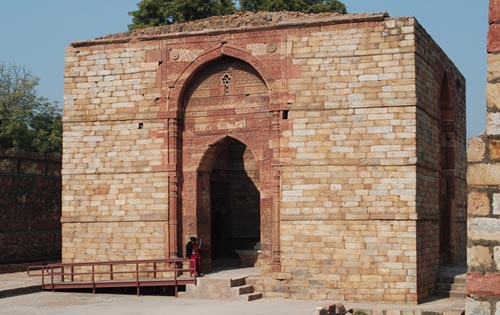Iltutmish Tomb

Information on Iltutmish Tomb (New Delhi) - History & Architecture
Iltutmish Tomb is a memorial tomb established by Shamshuddin Iltutmish in the year 1235. It is situated in the northwest side of Quwwatu'l Islam Mosque of New Delhi. Iltutmish Tomb has glorious history and simple yet sophisticated architecture. It is the first structure of India which used 'squinch arches'. Primarily revelling in honour, Iltutmish Tomb provides the rightest picture of the traditional times of India.
Iltutmish Tomb Architecture
Iltutmish Tomb was established through native architectural style. It possess red sand stone memorial in the core. Initially, the memorial was covered by a dome, which was later replaced by Feroze Shah Tughlug.Iltutmish Tomb has simple and unadorned exterior designs. However, its interiors are extravagantlydecorated with geometrical and arabesque designs. Furthermore, antique Hindu styles, for instance, wheel, bobble, lotus and diamond among others can also be observed in Iltutmish Tomb.
Iltutmish Tomb has three gateways, namely north, south and east respectively. The gates of the tomb is brilliantly carved. The accuracyand detailing of the gates is supreme with any other Indian architecture. In the west there is a wall which airs the detection of Mecca. The upper compartment of the tomb opens up to the sky. There is a four-sided enclosure in Iltutmish Tomb which seems simple from outside, but from the inside it looks thornily carved. Iltutmish Tomb is impaled from three sides by curved entries. Fine designs and borders highlight these curves and express significantly for the talents of Hindu craftsmanship.
Iltutmish Tomb History
Shamshuddin Iltutmish was an imperative ruler in India in late 12th century. He ruled over Indo-Gangetic region during 1211 to 1236. He was a slave of Qutbuddin Aibak and afterwards became his son-in-law and lieutenant. Qutbuddin Aibakwas army general of Muhamman Ghur, who assaulted India and conquered the enormous force of Rajput ruler namely Prithviraj Chauchan in 1192. In order to demonstrate the triumph, Qutbuddin Aibak has decided to create Qutub Minar and Quwwat Mosque as the sign of the strength of Islam. Qutbuddin Aibak started to establish his own realm after death of his leader. After Qutbuddin Aibak, when Shamshuddin Iltutmish took over the authority, he has made substantialdevelopment to QutbMinar along with Quwwat Mosque. In the year 1235, Shamshuddin Iltutmish decided to develop his individual tomb alongside Qutub Minar and Quwwat Mosque. Until 1235, Muslim rulers were subjected to pillaging Hindu and Jain architectures for the purpose of any construction. Thus, Shamshuddin Iltutmish has marked a shift on this aspect and developed a tomb solely based on his personal specification. It is worth mentioning that Shamshuddin Iltutmish has started the tradition of tomb construction and the first tomb was for his own son. Iltutmish Tobmb also demonstrate several Indian themes and architectural features.
Iltutmish Tomb Tourism Significance
Iltutmish Tomb is a place which is worth visiting, not only for its historical and architectural significance, but also to observe the impassive change in Indian architectural designs and planning. The accurateness of the form of the tomb along with the calligraphy is spectacular. Travellers can enjoy the combination of Hindu as well as Islamic arts by visiting Iltutmish Tomb. It is beautifully carved with lotuses, bobbles and chains among others which add to the attraction and glory of the memorial. The walls of the memorial also shed light on culturally rich history of India.
- Andaman Nicobar Monuments
- Andhra Pradesh Monuments
- Assam Monuments
- Bihar Monuments
- Chhattisgarh Monuments
- New Delhi Monuments
- Goa Monuments
- Gujarat Monuments
- Haryana Monuments
- Himachal Pradesh Monuments
- Jammu and Kashmir Monuments
- Karnataka Monuments
- Kerala Monuments
- Madhya Pradesh Monuments
- Maharashtra Monuments
- Odisha Monuments
- Punjab Monuments
- Rajasthan Monuments
- Tamil Nadu Monuments
- Telangana Monuments
- Uttar Pradesh Monuments
- West Bengal Monuments